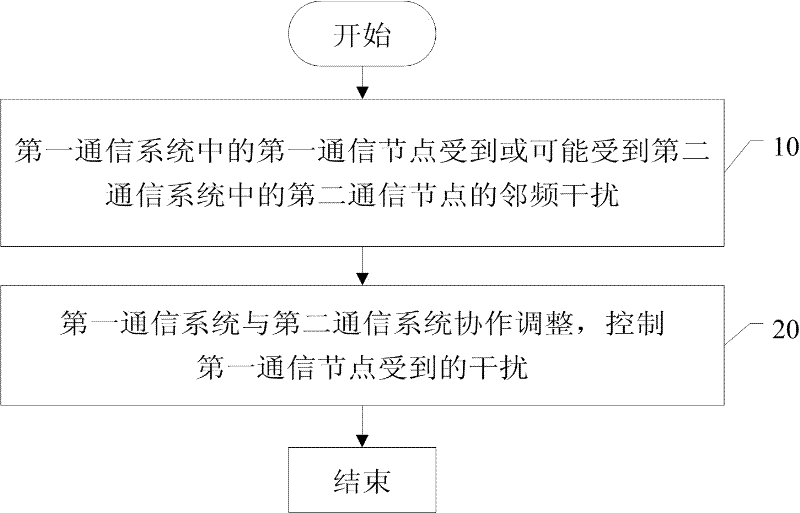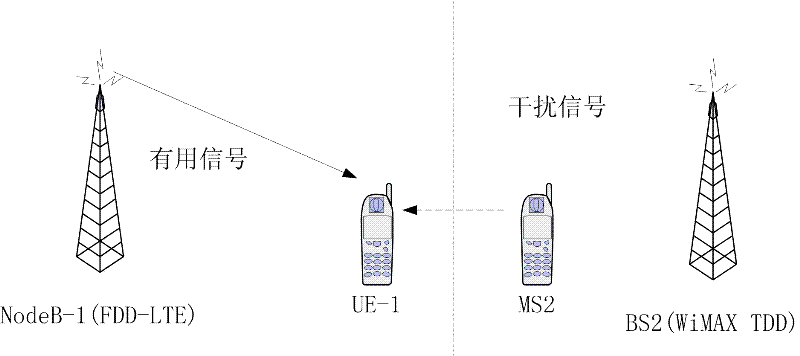Method and system for restraining interference between adjacent-channel coexisting systems
A technology of adjacent frequency interference and adjacent frequency coexistence, applied in the field of communication, can solve problems such as system performance degradation, and achieve the effect of improving adaptability, improving service quality and spectrum utilization efficiency
- Summary
- Abstract
- Description
- Claims
- Application Information
AI Technical Summary
Problems solved by technology
Method used
Image
Examples
application example 1
[0118] Such as image 3 As shown, when the WiMAX system and the FDD-LTE system coexist in adjacent frequencies, the terminal UE-1 in the FDD-LTE system is determined to be or may be interfered by the terminal MS-2 in the WiMAX system.
[0119] Such as Figure 4 As shown, the interference suppression method between adjacent frequency coexistence systems includes the following steps:
[0120] 1. The FDD-LTE system sends the signaling containing UE-1 parameter information to the WiMAX system; wherein, the UE-1 parameter information includes the reference signal information sent by UE-1;
[0121] 2. The WiMAX system uses control signaling to send the parameter information of UE-1 to MS-2;
[0122] 3. According to the received parameter information of UE-1, MS-2 judges whether it is or may be subjected to adjacent frequency interference from UE-1. frequency interference;
[0123] If the parameter information contains the location information of UE-1, MS-2 can judge whether UE-1...
application example 2
[0127] Such as image 3 As shown, when the WiMAX system and the FDD-LTE system coexist in adjacent frequencies, the terminal UE-1 in the FDD-LTE system may receive or be interfered by the terminal MS-2 in the WiMAX system.
[0128] Such as Figure 5 As shown, the interference suppression method between adjacent frequency coexistence systems includes the following steps:
[0129] 1. UE-1 determines that it is or may be interfered by terminal MS-2 in the WiMAX system according to the obtained parameter information of MS-2; the judgment method can be found in the previous application example;
[0130] 2. UE-1 sends the parameter information of MS-2 to its serving base station NodeB-1, and the FDD-LTE system to which NodeB-1 belongs sends the signaling containing the parameter information of MS-2 to the WiMAX system;
[0131] 3. The WiMAX system adjusts the resource allocation of MS-2 through the serving base station BS-2 of MS-2, so as to control the adjacent frequency interfer...
application example 3
[0133] Such as image 3 As shown, when the WiMAX system and the FDD-LTE system coexist in adjacent frequencies, the terminal UE-1 in the FDD-LTE system may receive or be interfered by the terminal MS-2 in the WiMAX system.
[0134] Such as Figure 6 As shown, the interference suppression method between adjacent frequency coexistence systems includes the following steps:
[0135] 1. UE-1 determines that it is or may be interfered by terminal MS-2 in the WiMAX system according to the obtained parameter information of MS-2; the judgment method can be seen in Application Example 1;
[0136] 2. UE-1 directly sends the obtained parameter information of MS-2 to the WiMAX system (such as the serving base station BS-2 of MS-2) through signaling, and the WiMAX system adjusts the MS-2 parameter information through the serving base station BS-2 of MS-2. 2 to control the adjacent frequency interference from MS-2 to UE-1.
PUM
 Login to View More
Login to View More Abstract
Description
Claims
Application Information
 Login to View More
Login to View More - R&D
- Intellectual Property
- Life Sciences
- Materials
- Tech Scout
- Unparalleled Data Quality
- Higher Quality Content
- 60% Fewer Hallucinations
Browse by: Latest US Patents, China's latest patents, Technical Efficacy Thesaurus, Application Domain, Technology Topic, Popular Technical Reports.
© 2025 PatSnap. All rights reserved.Legal|Privacy policy|Modern Slavery Act Transparency Statement|Sitemap|About US| Contact US: help@patsnap.com



